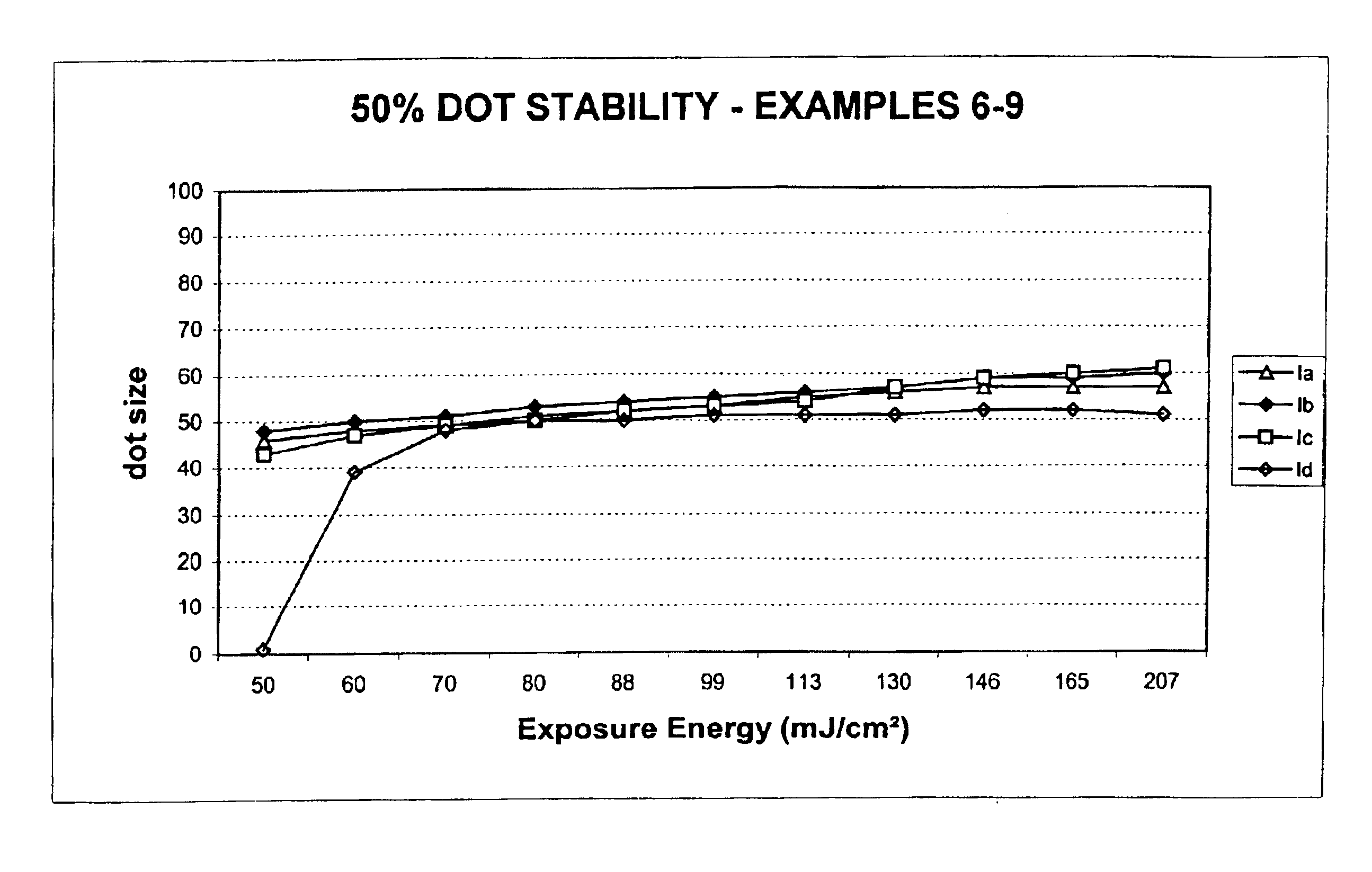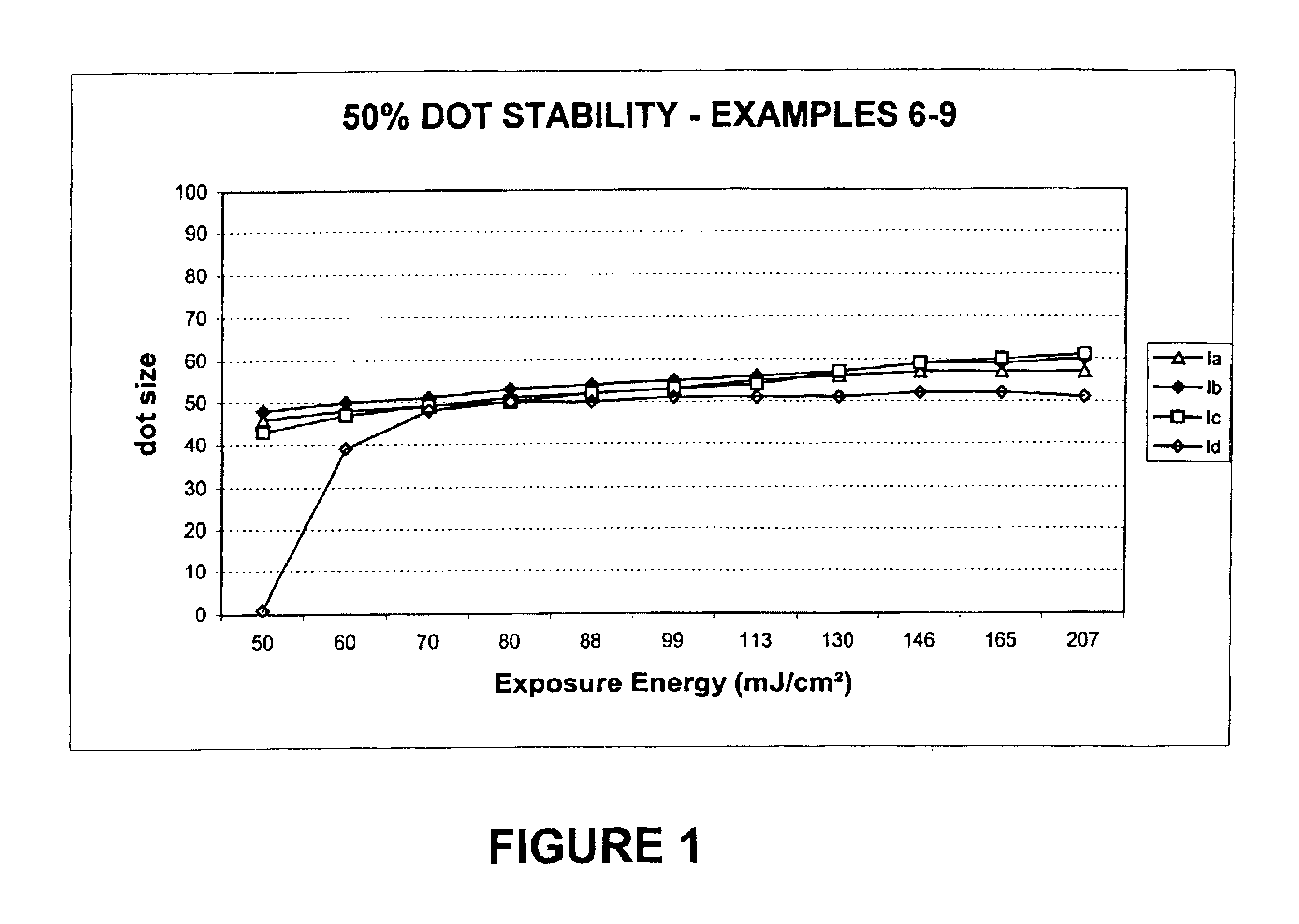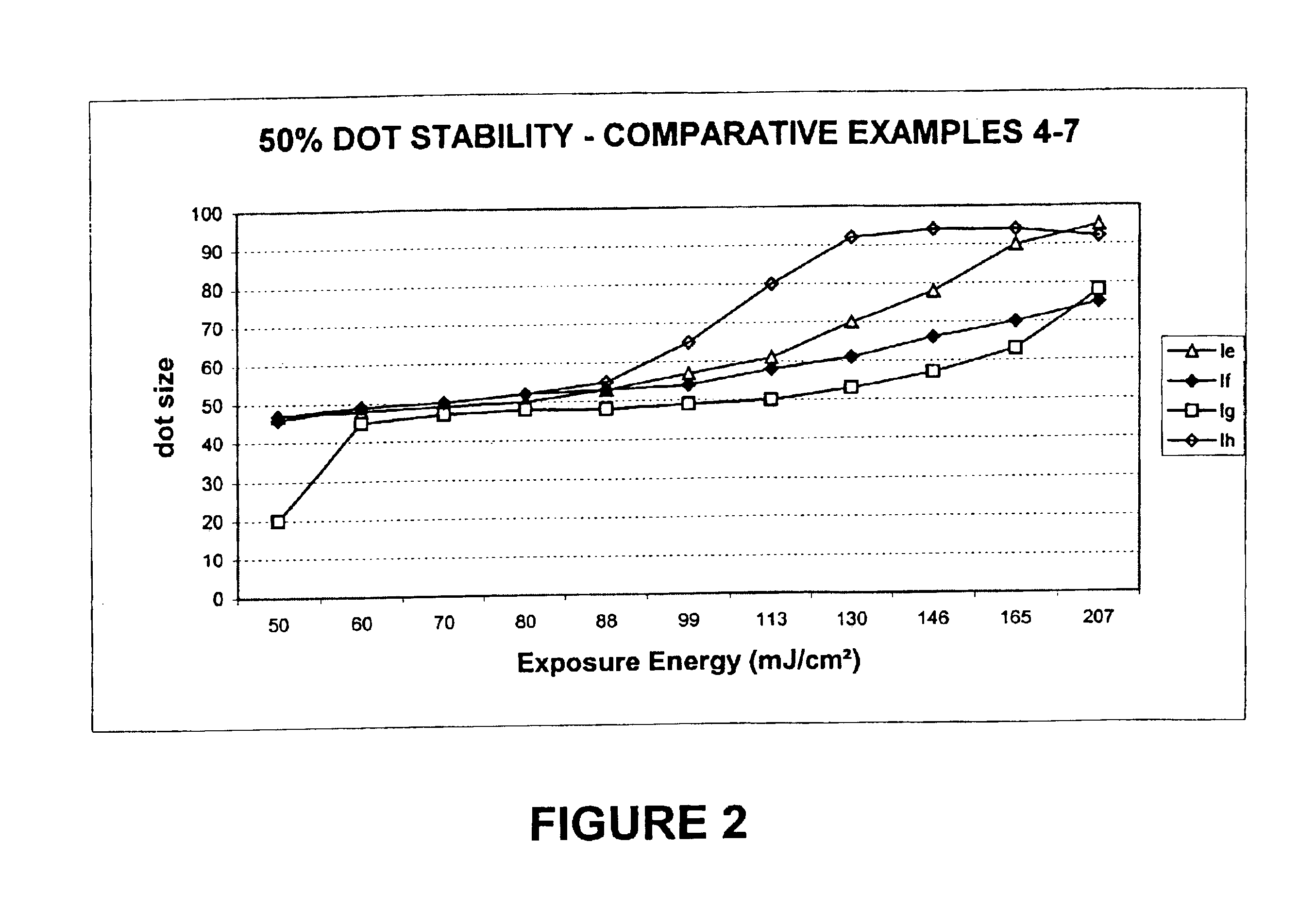Infrared absorbing compounds and their use in photoimageable elements
a technology of infrared absorption and imageable elements, applied in thermography, instruments, photosensitive materials, etc., can solve the problems of time-consuming process, small change in mask dimension, and loss of dot, and achieve the effect of improving dot stability and less variation of dot size with exposur
- Summary
- Abstract
- Description
- Claims
- Application Information
AI Technical Summary
Benefits of technology
Problems solved by technology
Method used
Image
Examples
example 1
[0109]Preparation of 2-[2-[2-chloro-3-[(1,3-dihydro-1,3,3-trimethyl-2H-indol-2-ylidene)ethylidene]-1-cyclohexen-1-yl]ethenyl]-1,3,3-trimethyl-3H-Indolium, salt with 4,5-dihydroxy-1,3-Benzenedisulfonic acid (2:1) (Infrared absorbing compound Ia).
[0110]56.2 g of KF654B was dissolved in 1000 g of water and 1000 g of ethanol. 31.4 g of Disodium 4,5-dihydroxy-1,3-benzenedisulfonic acid (Aldrich, Milwaukee, Wis., USA) was dissolved in 200 g of water and 200 g of ethanol. The KF654B solution was slowly added to the solution of the sulfonic acid salt with stirring. The reaction mixture was stirred for another 10 minutes and stored in the dark at room temperature for 2 hours. The resulting precipitate was filtered off and dried in vacuum. Yield: 66 g.
[0111]Proton NMR (in DMSO-d6): δ 1.67 (24H, s), 1.86 (4H, br), 2.72 (8H, t), 3.68 (12H, s), 6.30 (4H, d), 6.97 (1H, s), 7.20-7.35 (5H, m), 7.35-7.50 (8H, m), 7.63 (4H, d), 8.25 (4H, d), 8.88 (1H, s) and 10.58 (1H, s).
example 2
[0112]Preparation of 2-[2-[3-[(1,3-Dihydro-1,3,3-trimethyl-2H-indol-2-ylidene)ethylidene]-2-phenylthio-1-cyclohexen-1-yl]ethenyl]-1,3,3-trimethyl-3H-indolium, salt with 4,5-dihydroxy-1,3-Benzenedisulfonic acid (2:1) (Infrared absorbing compound 1b).
[0113]5.9 g of Dye 66e was dissolved in 100 g of water and 100 g of methanol. 3.2 g of Disodium 4,5-dihydroxy-1,3-benzenedisulfonic acid (Aldrich, Milwaukee, Wis., USA) was dissolved in 30 g of water and 30 g of methanol. The Dye 66e solution was slowly added to the solution of the sulfonic acid salt with stirring. The reaction mixture was stored in the dark at room temperature for 2 hours. The resulting oily solid was collected by decanting the solvent, washed with 50 ml of water, and dried at ambient temperature for 48 hours. Yield: 6.9 g. The crude product contains small amount of methanol. It can be purified by recrystallization in water / methanol.
[0114]Proton NMR (in DMSO-d6): δ 1.41 (24H, s), 1.92 (4H, br), 2.76 (8H, t), 3.64 (12H, s...
example 3
[0115]Preparation of 2-[2-[3-[(1,3-Dihydro-1,3,3-trimethyl-2H-indol-2-ylidene)ethylidene]-2-phenylthio-1-cyclohexen-1-yl]ethenyl]-1,3,3-trimethyl-3H-indolium, salt with 10-camphorsulfonic acid (1:1) (Infrared absorbing compound Ic).
[0116]5.9 g of Dye 66e was dissolved in 100 g of water and 100 g of methanol. 7.0 g of Sodium 10-camphorsulfonic acid (Aldrich, Milwaukee, Wis., USA) was dissolved in 30 g of water and 30 g of methanol. The Dye 66e solution was slowly added to the solution of the sulfonic acid salt with stirring. No precipitate formed. The reaction mixture was stored in a laboratory hood at room temperature overnight. An oily solid formed when the methanol was evaporated. The solvent was decanted and the product washed with 50 ml of water. The product was dried at ambient temperature for 48 hours. Yield: 4.5 g.
[0117]Proton NMR (in DMSO-d6): δ 0.73 (3H, s), 1.05 (3H, s), 1.25 (2H, d), 1.41 (12H, s), 1.70-2.00 (5H, m), 2.22 (1H, d), 2.35 (1H, d), 2.60-2.90 (6H, m), 3.65 (6H...
PUM
| Property | Measurement | Unit |
|---|---|---|
| Fraction | aaaaa | aaaaa |
| Acidity | aaaaa | aaaaa |
| Polymeric | aaaaa | aaaaa |
Abstract
Description
Claims
Application Information
 Login to View More
Login to View More - R&D Engineer
- R&D Manager
- IP Professional
- Industry Leading Data Capabilities
- Powerful AI technology
- Patent DNA Extraction
Browse by: Latest US Patents, China's latest patents, Technical Efficacy Thesaurus, Application Domain, Technology Topic, Popular Technical Reports.
© 2024 PatSnap. All rights reserved.Legal|Privacy policy|Modern Slavery Act Transparency Statement|Sitemap|About US| Contact US: help@patsnap.com










